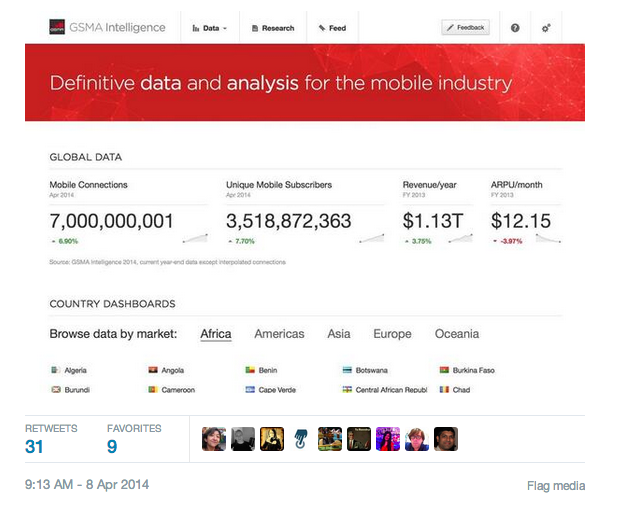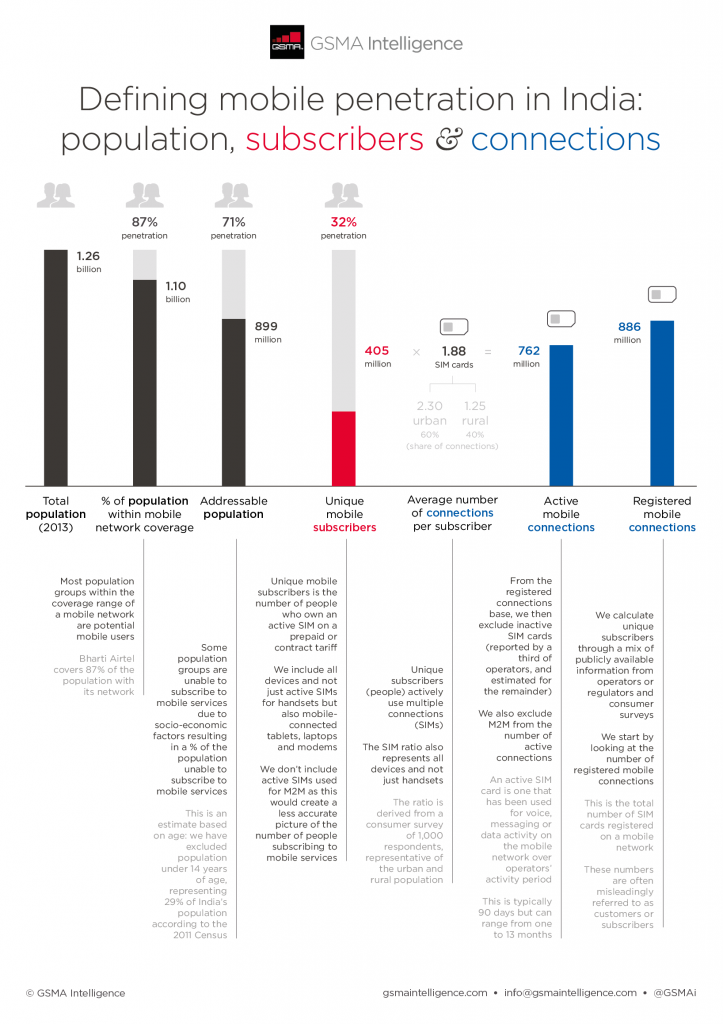Over at GSMA Intelligence (www.gsmaintelligence.com), we have a ticker that counts the number of global mobile connections. Last week, the ticker flipped past 7 billion, a significant milestone, and a moment we (almost) captured in this screenshot.
The global population is currently estimated to be 7.2 billion people so we’re rapidly approaching the point where there are as many mobile connections as people on the planet. That’s not bad for an industry that didn’t even exist just a few decades ago.
However, it’s wrong to assume that nearly every single person on the planet is connected to a mobile network. Indeed, there’s a substantial difference between the number of mobile connections and what GSMA Intelligence terms “unique mobile subscribers”.
What’s the difference? A unique mobile subscriber is one human being who subscribed to mobile services and that individual can have multiple mobile connections (i.e. SIM cards). In the developed world, an individual typically accounts for more than one mobile connection because they own more than one device; for example, if you own a smartphone and tablet with separate SIMs, you hold two connections. In emerging markets, subscribers are more likely to hold multiple SIMs, swapping them to take advantage of the best tariffs in a given situation.
This multiple SIM (or device) phenomenon has powered mobile connections growth over recent years, but it can often distort ‘real’ subscriber penetration. This is why GSMA Intelligence simultaneously tracks the number of unique mobile subscribers alongside connections. To do this we conduct primary research across a wide range of developed and emerging markets to ascertain the number of SIMs actively used by individual subscribers. We estimate that the global figure is 1.8 SIMs per user, which means the 7 billion connections equates to about 3.5 billion unique mobile subscribers. So rather than every person on the planet being a mobile subscriber, the reality is less than half are currently connected.
Understanding the difference between connections and subscribers is crucial in order to accurately measure market penetration and growth opportunities. To demonstrate how to calculate what proportion of a country’s population is subscribed to a mobile service, GSMA Intelligence has prepared the following infographic, using India – the world’s second-largest mobile market – as an example.
One important element to define is the addressable population: in India, 29% of the population is under 14 years of age, a group that we consider to be unlikely to subscribe to mobile services. On that basis, the addressable population is reduced by a total of 29%, from 1.26 billion people to 899 million. Mobile subscriber penetration is therefore unlikely to surpass 71%, unless market dynamics change. In contrast, penetration based on connections is likely to continue growing exponentially to go beyond the 100% mark.
According to our primary research (surveying 1,000 respondents), Indian subscribers held around 1.9 SIM cards on average in Q4 2013, which means that unique subscriber penetration encompasses around one third (32%) of the entire population – resulting in 405 million unique subscribers – which in turns represents just under half of the addressable population base. Our survey showed that the SIM ratio has declined between 2012 and 2013 mainly due to the effect of SIM registration (from 2.1 to 1.9).
GSMA Intelligence has also conducted research, found here, into what the multiple SIM ownership phenomenon means for average revenue per user (ARPU), the method used in the industry to measure consumers’ spending on mobile services. ARPU is traditionally based on mobile connections and on this basis has been in decline in most regions over the last decade. However, when ARPU is considered on a unique subscriber basis, the research shows that consumers in several countries are actually increasing their spending on mobile services.
Operators are changing their reporting methods to reflect this dynamic. Verizon Wireless, for example, now tracks average revenue per account (ARPA) rather than per user, which takes into account that many of its subscribers hold multiple devices and are able to spread their data allowance across several devices or SIMs.
So what does all this mean for the 7 billion milestone? The fact that there will soon be as many mobile connections as people on the planet is a huge achievement for our industry. But this isn’t the end of the story, it’s the beginning. Working to connect the one in two in the world who currently don’t have access to mobile will define the exciting next chapter.



